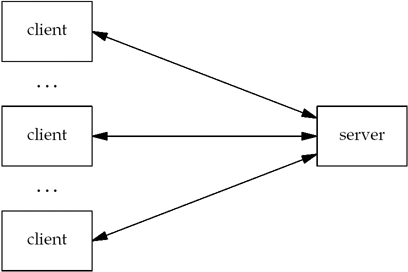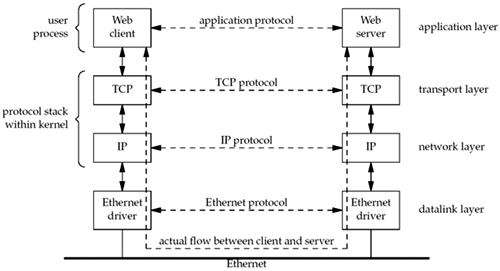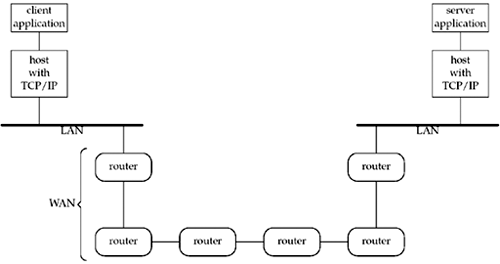1.1 Introduction
When writing programs that communicate across a
computer network, one must first invent a protocol, an agreement on how those programs
will communicate. Before delving into the design details of a
protocol, high-level decisions must be made about which program is
expected to initiate communication and when responses are expected.
For example, a Web server is typically thought of as a long-running
program (or daemon) that sends
network messages only in response to requests coming in from the
network. The other side of the protocol is a Web client, such as a
browser, which always initiates communication with the server. This
organization into client and
server is used by most
network-aware applications. Deciding that the client always
initiates requests tends to simplify the protocol as well as the
programs themselves. Of course, some of the more complex network
applications also require asynchronous
callback communication, where the server initiates a message
to the client. But it is far more common for applications to stick
to the basic client/server model shown in Figure 1.1.

Clients normally communicate with one server at
a time, although using a Web browser as an example, we might
communicate with many different Web servers over, say, a 10-minute
time period. But from the server's perspective, at any given point
in time, it is not unusual for a server to be communicating with
multiple clients. We show this in Figure 1.2. Later in this text, we will cover
several different ways for a server to handle multiple clients at
the same time.

The client application and the server
application may be thought of as communicating via a network
protocol, but actually, multiple layers of network protocols are
typically involved. In this text, we focus on the TCP/IP protocol
suite, also called the Internet protocol suite. For example, Web
clients and servers communicate using the Transmission Control
Protocol, or TCP. TCP, in turn, uses the Internet Protocol, or IP,
and IP communicates with a datalink layer of some form. If the
client and server are on the same Ethernet, we would have the
arrangement shown in Figure
1.3.

Even though the client and server communicate
using an application protocol, the transport layers communicate
using TCP. Note that the actual flow of information between the
client and server goes down the protocol stack on one side, across
the network, and up the protocol stack on the other side. Also note
that the client and server are typically user processes, while the
TCP and IP protocols are normally part of the protocol stack within
the kernel. We have labeled the four layers on the right side of
Figure 1.3.
TCP and IP are not the only protocols that we
will discuss. Some clients and servers use the User Datagram
Protocol (UDP) instead of TCP, and we will discuss both protocols
in more detail in Chapter 2. Furthermore, we have
used the term "IP," but the protocol, which has been in use since
the early 1980s, is officially called IP
version 4 (IPv4). A new version, IP version 6 (IPv6) was developed during the
mid-1990s and could potentially replace IPv4 in the years to come.
This text covers the development of network applications using both
IPv4 and IPv6. Appendix A provides a comparison
of IPv4 and IPv6, along with other protocols that we will
discuss.
The client and server need not be attached to
the same local area network (LAN)
as we show in Figure 1.3.
For instance, in Figure
1.4, we show the client and server on different LANs, with both
LANs connected to a wide area
network (WAN) using routers.

Routers are the building blocks of WANs. The
largest WAN today is the Internet.
Many companies build their own WANs and these private WANs may or
may not be connected to the Internet.
The remainder of this chapter provides an
introduction to the various topics that are covered in detail later
in the text. We start with a complete example of a TCP client,
albeit a simple one, that demonstrates many of the function calls
and concepts that we will encounter throughout the text. This
client works with IPv4 only, and we show the changes required to
work with IPv6. A better solution is to write protocol-independent
clients and servers, and we will discuss this in Chapter 11. This chapter also
shows a complete TCP server that works with our client.
To simplify all our code, we define our own
wrapper functions for most of the system functions that we call
throughout the text. We can use these wrapper functions most of the
time to check for an error, print an appropriate message, and
terminate when an error occurs. We also show the test network,
hosts, and routers used for most examples in the text, along with
their hostnames, IP addresses, and operating systems.
Most discussions of Unix these days include the
term "X," which is the standard that most vendors have adopted. We
describe the history of POSIX and how it affects the Application
Programming Interfaces (APIs) that we describe in this text, along
with the other players in the standards arena.
|